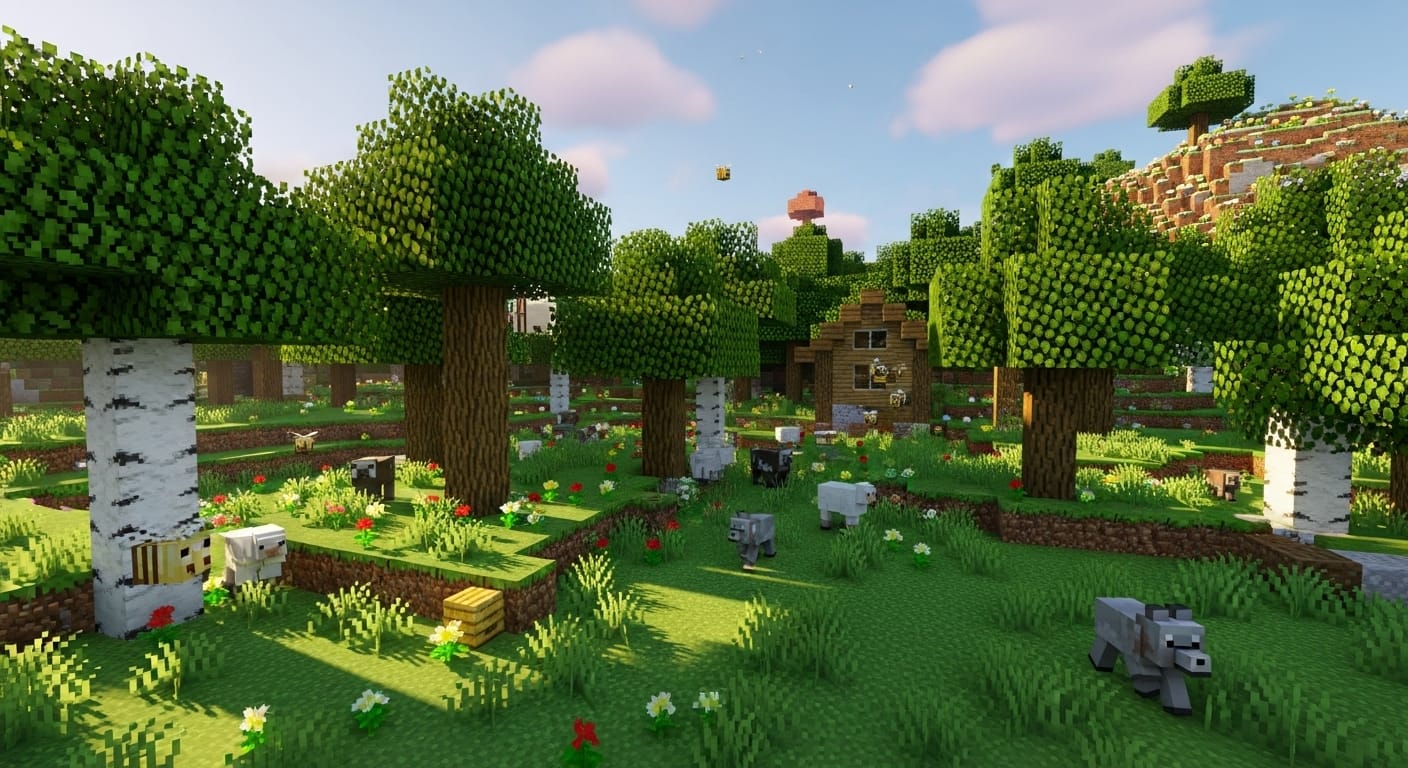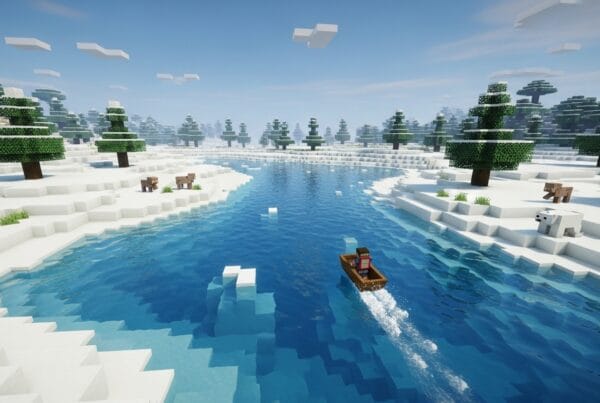The Forest Biome in Minecraft is one of the most common and resource-rich environments in the Overworld. It’s a lush, green biome filled with oak and birch trees, friendly animals, and abundant resources—making it an ideal starting point for both new and experienced players.
This guide covers everything you need to know about the Forest Biome: its mobs, trees, resources, structures, survival strategies, and even hidden details that can make your gameplay smoother and more rewarding.
Forest Biome Overview
Location and Generation
The Forest Biome generates in the Overworld’s temperate regions, often neighboring plains, taigas, or mountains. The terrain features rolling hills, small ponds, and cave openings, with moderate foliage density that can slightly reduce visibility.
Forests can appear at various elevations, and since Minecraft 1.18 (“Caves & Cliffs” update), terrain generation can cause forested hills or cliffsides, creating scenic variations.
Climate and Weather
- Temperature: 0.7 (temperate)
- Rain: Frequent rainfall, no snow
- Light Level: Varies due to dense tree cover; shaded areas can drop below level 7, allowing hostile mobs to spawn even during the day
💡 Tip: Because of the uneven lighting under trees, it’s smart to light up clearings and paths with torches to avoid surprise mob attacks.
All Tree Types in the Forest Biome
Forests are the best biome for wood collectors, as trees grow densely and regrow easily from saplings.
| Tree Type | Wood Color | Unique Features | Common Uses |
|---|---|---|---|
| Oak | Light brown | Drops apples; easy to grow anywhere | Tools, building, crafting, fuel |
| Birch | Pale white | Smooth, bright texture; tall variants in Birch Forests | Decorative builds, flooring |
| Flower Forest (Oak) | Light brown | Surrounded by colorful flowers and bees | Honey farming, decoration |
🌳 Apple Drop Rate: Oak leaves have a 0.5% chance (1 in 200) of dropping apples when broken or decayed, making the forest an early food source.
Mobs Found in the Forest Biome
Passive Mobs
These creatures commonly spawn on grass blocks with sufficient light (level 9+):
- 🐑 Sheep – Provides wool and mutton
- 🐄 Cows – Drops beef and leather
- 🐖 Pigs – Source of porkchops
- 🐔 Chickens – Lay eggs and drop feathers
- 🐝 Bees – Found near flower patches, especially in Flower Forest variants
Neutral Mobs
- 🐺 Wolves – Can be tamed with bones; spawn naturally in Forest and Taiga biomes
Hostile Mobs
At night or in dark areas (light level ≤ 7), the following mobs appear:
- 💀 Skeletons
- 🧟 Zombies
- 🕷️ Spiders
- 💣 Creepers
- 👹 Endermen (rare nighttime spawn)
🔥 Pro Tip: Due to shade from trees, hostile mobs can linger during the day—always clear trees near your base for safety.
Structures and Points of Interest
While forests themselves lack exclusive structures, they often border biomes with high-structure density, making them strategic for exploration.
Possible structures near or within Forest Biomes:
- Ruined Portals – Generate between trees; offer loot and obsidian
- Villages – Common on plains-forest borders
- Caves & Ravines – Surface openings are frequent, leading to early ore access
- Bee Nests – Naturally generate on oak and birch trees (5% chance per tree near flowers)
Since forests often connect to plains or mountains, they make ideal central hubs for building bases between resource-rich areas.
Resources and Materials
Forests provide nearly all basic survival materials you need:
| Resource | Source | Use |
|---|---|---|
| Wood (Oak, Birch) | Trees | Building, crafting, smelting |
| Apples | Oak leaves | Early food or golden apples |
| Bees & Honey | Bee nests | Honey bottles, honey blocks |
| Flowers | Flower Forest variant | Dyes, bee pollination |
| Mushrooms | Shaded forest floor | Mushroom stew |
| Coal & Stone | Surface outcrops | Smelting, tools |
💡 Extra Tip: Since bees spawn naturally in Flower Forests, players can easily set up early-game honey farms without traveling far.
Survival Tips for Forest Biome Players
Early Game
- Punch trees immediately for tools and shelter materials.
- Build a temporary base in a clearing—dense trees block your line of sight.
- Use fallen apples and animals for food before farming begins.
Mid Game
- Craft torches to illuminate your base perimeter.
- Begin a tree farm for renewable wood.
- Use beehives for honey and wax production.
Late Game
- Use the forest as a base aesthetic — perfect for wood cabins or treehouse builds.
- Expand into adjacent biomes (like plains or mountains) for variety and farming.
- Automate resource collection with villager trading and bee farms.
Forest Biome Variants
Minecraft features several forest variants, each with unique terrain, flora, and difficulty levels:
| Variant | Key Features | Difficulty Level |
|---|---|---|
| Birch Forest | Tall birch trees, light atmosphere | 🟢 Easy |
| Flower Forest | Every flower type, bees, vibrant colors | 🟢 Easy |
| Dark Forest | Thick canopy, giant mushrooms, mobs spawn during day | 🟠 Moderate |
| Old Growth Birch Forest | Extremely tall birch trees, scenic terrain | 🟢 Easy |
| Old Growth Pine/Spruce Taiga | (Forest-adjacent cold variants) | 🟡 Medium |
🌸 Flower Forest Note: All flower varieties generate here, making it the only biome where you can collect every dye color from natural sources.
🍄 Dark Forest Note: The canopy is so dense that light levels stay below 7—expect zombies and skeletons even at noon. Bring torches or glowstone.
Version History and Updates
- 1.18+ (Caves & Cliffs): Forest terrain became more elevated and irregular.
- 1.19 (Wild Update): Bee nest generation improved near flower patches.
- 1.20+: Forest biomes integrate more naturally with nearby meadow and cherry grove areas, creating smoother transitions and richer landscapes.
💾 Java vs Bedrock: Generation patterns are nearly identical, but mob spawning density may vary slightly between versions.
Fun Facts and Trivia
- Forests are one of the most common world spawn biomes.
- Wolves are most likely to spawn in forests and taigas.
- Flower Forests are a rare sub-biome (only about 1 in 32 forest chunks).
- Dark Forests contain giant mushrooms, useful for farming mushroom blocks.
- Many community builds feature treehouse bases or woodland villages here due to easy access to wood and scenic landscapes.
Conclusion
The Forest Biome remains a cornerstone of Minecraft’s survival experience — a perfect mix of beauty, practicality, and accessibility. It’s the ideal starting point for players seeking an easy yet resourceful environment, with natural pathways to more challenging regions like Dark Forests or mountain ranges.
Whether you’re taming wolves, building a cabin among the trees, or farming honey from bees, the Forest Biome is where countless Minecraft adventures begin — and often, where they thrive. 🌲






